These highlights do not include all the information needed to use CARMUSTINE FOR INJECTION safely and effectively. See full prescribing information for CARMUSTINE FOR INJECTION. CARMUSTINE for injection, for intravenous use Initial U.S. Approval: 1977
CARMUSTINE by
Drug Labeling and Warnings
CARMUSTINE by is a Prescription medication manufactured, distributed, or labeled by Accord Healthcare Inc., Intas Pharmaceuticals Limited. Drug facts, warnings, and ingredients follow.
Drug Details [pdf]
CARMUSTINE - carmustine
Accord Healthcare Inc.
----------
HIGHLIGHTS OF PRESCRIBING INFORMATIONThese highlights do not include all the information needed to use CARMUSTINE FOR INJECTION safely and effectively. See full prescribing information for CARMUSTINE FOR INJECTION.
CARMUSTINE for injection, for intravenous use Initial U.S. Approval: 1977 WARNING: MYELOSUPPRESSION and PULMONARY TOXICITYSee full prescribing information for complete boxed warning
INDICATIONS AND USAGECarmustine for Injection is a nitrosourea indicated as palliative therapy as a single agent or in established combination therapy with other approved chemotherapeutic agents in the following:
DOSAGE AND ADMINISTRATION
DOSAGE FORMS AND STRENGTHSFor injection:
CONTRAINDICATIONS
WARNINGS AND PRECAUTIONS
ADVERSE REACTIONSMost common adverse reactions (>1%) are nausea, vomiting, renal toxicity, pneumonitis, pulmonary toxicity, myelosuppression ( 6) To report SUSPECTED ADVERSE REACTIONS, contact Accord Healthcare Inc. at 1-866-941-7875 or FDA at 1-800-FDA-1088 or www.fda.gov/medwatch. DRUG INTERACTIONSUSE IN SPECIFIC POPULATIONS
See 17 for PATIENT COUNSELING INFORMATION. Revised: 5/2022 |
FULL PRESCRIBING INFORMATION
WARNING: MYELOSUPPRESSION and PULMONARY TOXICITY
Myelosuppression
Carmustine for Injection causes suppression of marrow function (including thrombocytopenia and leukopenia), which may contribute to bleeding and overwhelming infections. [see Warnings and Precautions (5.1) and Adverse Reactions (6)] . Monitor blood counts weekly for at least 6 weeks after each dose. Adjust dosage based on nadir blood counts from the prior dose [see Dosage and Administration (2.1)] . Do not administer a repeat course of Carmustine for Injection until blood counts recover.
Pulmonary Toxicity
Carmustine for Injection causes dose-related pulmonary toxicity. Patients receiving greater than 1400 mg/m 2 cumulative dose are at significantly higher risk than those receiving less. Delayed pulmonary toxicity can occur years after treatment, and can result in death, particularly in patients treated in childhood [see Adverse Reactions (6) and Use in Specific Populations (8.4)] .
1 INDICATIONS AND USAGE
Carmustine for Injection is indicated as palliative therapy as a single agent or in established combination therapy in the following:
- Brain tumors glioblastoma, brainstem glioma, medulloblastoma, astrocytoma, ependymoma, and metastatic brain tumors.
- Multiple myeloma in combination with prednisone.
- Relapsed or refractory Hodgkin's lymphoma in combination with other approved drugs.
- Relapsed or refractory non-Hodgkin's lymphomas in combination with other approved drugs.
2 DOSAGE AND ADMINISTRATION
2.1 Recommended Dosage
The recommended dosage of Carmustine for Injection as a single agent in previously untreated patients is 150 mg/m 2 to 200 mg/m 2 intravenously every 6 weeks. Administer as a single dose or divided into daily injections such as 75 mg/m 2 to 100 mg/m 2 on two successive days. Lower the dose when Carmustine for Injection is used with other myelosuppressive drugs or in patients in whom bone marrow reserve is depleted. Administer Carmustine for Injection for the duration according to the established regimen. Premedicate each dose with anti-emetics.
Adjust doses subsequent to the initial dose according to the hematologic response of the patient to the preceding dose. The following schedule is suggested as a guide to dosage adjustment:
| Nadir After Prior Dose
| Percentage of Prior Dose to
be Given |
|
| Leukocytes/mm
3
| Platelets/mm
3
| |
| More than 4000
| More than 100,000
| 100%
|
| 3000-3999
| 75,000-99,999
| 100%
|
| 2000-2999
| 25,000-74,999
| 70%
|
| Less than 2000
| Less than 25,000
| 50%
|
The hematologic toxicity can be delayed and cumulative. Monitor blood counts weekly. Do not administer a repeat course of Carmustine for Injection until circulating blood elements have returned to acceptable levels (platelets above 100 Gi/L, leukocytes above 4 Gi/L and absolute neutrophil count above 1 Gi/L). The usual interval between courses is 6 weeks.
Evaluate renal function prior to administration and periodically during treatment. For patients with compromised renal function, monitor for toxicity more frequently. Discontinue Carmustine for Injection if the creatinine clearance is less than 10 mL/min. Do not administer Carmustine for Injection to patients with compromised renal function. Monitor transaminases and bilirubin periodically during treatment. [see Adverse Reactions (6)].
2.2 Preparation and Administration of Intravenous Solution
Refer to the Carmustine for Injection Instructions for Use for further details and instructions.
Carmustine for Injection, 50 mg/vial (preparation of reconstituted and diluted solution)
- Dissolve Carmustine for Injection, 50 mg with 1.5 mL of the supplied sterile diluent (Dehydrated Alcohol Injection, USP, 3 mL). Sterile diluent vial contains 3 mL. Only use 1.5 mL to reconstitute Carmustine for injection, 50 mg and discard remaining quantity of diluent in vial.
- Aseptically add 13.5 mL Sterile Water for Injection, USP.
- Each mL of resulting solution contains 3.3 mg of Carmustine for Injection in 10% ethanol. Such solutions should be protected from light.
- The reconstituted solution is a clear, colorless to yellowish solution.
- Once reconstituted, the solution must be further diluted with 0.9% Sodium Chloride Injection, USP or 5% Dextrose Injection, USP.
- Examine reconstituted vials for crystal formation prior to use. If crystals are observed, they may be re-dissolved by warming the vial to room temperature with agitation.
- Carmustine for Injection should be diluted immediately after reconstitution.
- Do not store the reconstituted solution.
- Parenteral drug products should be inspected visually for particulate matter and discoloration prior to administration, whenever solution and container permit.
- Examine reconstituted vials for crystal formation prior to use. If crystals are observed, they may be re-dissolved by warming the vial to room temperature with agitation.
- Dilute reconstituted vials with either 250 mL of 0.9% Sodium Chloride Injection, USP or 5% Dextrose Injection, USP, in glass or polypropylene containers to a concentration of 0.2 mg/mL. If not used immediately, store at room temperature (20°C to 25°C or 68°F to 77°F), protect from light and utilize within 2 hours. May be stored for up to 12 hours refrigerated (2°C to 8°C or 36°F to 46°F) and an additional 2 hours at room temperature (20°C to 25°C or 68°F to 77°F) protected from light.
Carmustine for Injection, 300 mg/vial (preparation of reconstituted and diluted solution)
- Dissolve Carmustine for Injection, 300 mg with 9 mL of the supplied sterile diluent (Dehydrated Alcohol Injection, USP, 9 mL).
- Aseptically add 81 mL Sterile Water for Injection, USP.
- Each mL of resulting solution contains 3.3 mg of Carmustine for Injection in 10% ethanol. Such solutions should be protected from light.
- The reconstituted solution is a clear, colorless to yellowish solution.
- Once reconstituted, the solution must be further diluted with 0.9% Sodium Chloride Injection, USP or 5% Dextrose Injection, USP.
- Examine reconstituted vials for crystal formation prior to use. If crystals are observed, they may be re-dissolved by warming the vial to room temperature with agitation.
- Carmustine for Injection, USP should be diluted immediately after reconstitution.
- Do not store the reconstituted solution.
- Parenteral drug products should be inspected visually for particulate matter and discoloration prior to administration, whenever solution and container permit.
- Examine reconstituted vials for crystal formation prior to use. If crystals are observed, they may be re-dissolved by warming the vial to room temperature with agitation.
- Dilute reconstituted vials with either 1,500 mL of 0.9% Sodium Chloride Injection, USP or 5% Dextrose Injection, USP, in glass or polypropylene containers to a concentration of 0.2 mg/mL. If not used immediately, store at room temperature (20°C to 25°C or 68°F to 77°F), protect from light and utilize within 2 hours. May be stored for up to 12 hours refrigerated (2°C to 8°C or 36°F to 46°F) and an additional 2 hours at room temperature (20°C to 25°C or 68°F to 77°F) protected from light.
Administration of Intravenous Solution:
- Administer reconstituted solution by slow intravenous infusion over at least two hours. Administration of Carmustine for Injection over a period of less than two hours can lead to pain and burning at the site of injection. Monitor the injected area during the administration. The rate of administration of the intravenous infusion should not be more than 1.66 mg/m 2/min.
- See Section 16 for important instructions on the storage and handling of the injection. Carmustine for Injection is a hazardous drug. Follow applicable special handling and disposal procedures. 1
- The lyophilized dosage formulation contains no preservatives and is not intended for use as a multiple dose vial.
Accidental contact of reconstituted Carmustine for Injection with the skin has caused transient hyperpigmentation of the affected areas. Wear impervious gloves to minimize the risk of dermal exposure impervious gloves when handling vials containing Carmustine for Injection. Immediately wash the skin or mucosa thoroughly with soap and water if Carmustine for Injection lyophilized material or solution contacts the skin or mucosa 1.
3 DOSAGE FORMS AND STRENGTHS
For injection:
- 50 mg of carmustine as a lyophilized powder in a single-dose vial for reconstitution and a vial containing 3 mL sterile diluent (Dehydrated Alcohol Injection, USP, 3 mL).
- 300 mg of carmustine as a lyophilized powder in a single-dose vial for reconstitution and a vial containing 9 mL sterile diluent (Dehydrated Alcohol Injection, USP, 9 mL).
4 CONTRAINDICATIONS
Carmustine for Injection is contraindicated in patients with previous hypersensitivity to Carmustine for Injection or its components.
5 WARNINGS AND PRECAUTIONS
5.1 Myelosuppression
Bone marrow toxicity is a dose-limiting, common and severe toxic effect of carmustine, occurring 4-6 weeks after drug administration (thrombocytopenia occurs at about 4 weeks post-administration persisting for 1 to 2 weeks; leukopenia occurs at 5 to 6 weeks after a dose of carmustine persisting for 1 to 2 weeks; thrombocytopenia is generally more severe than leukopenia; anemia is less frequent and less severe compared to thrombocytopenia and/or leukopenia) Complete blood count should therefore be monitored weekly for at least six weeks after a dose. Repeat doses of Carmustine for Injection should not be given more frequently than every six weeks.
The bone marrow toxicity of carmustine is cumulative and therefore the dosage adjustment must be considered on the basis of nadir blood counts from prior dose [see Adverse Reactions (6)] . Greater myelotoxicity (e.g., leukopenia and neutropenia) has been reported when carmustine was combined with cimetidine [see Drug Interactions (7)] .
5.2 Pulmonary Toxicity
Cases of fatal pulmonary toxicity with carmustine have been reported. Pulmonary toxicity characterized by pulmonary infiltrates and/or fibrosis has been reported to occur from 9 days to 43 months after treatment with carmustine and related nitrosoureas. Pulmonary toxicity from carmustine is dose-related. Patients receiving greater than 1400 mg/m 2 cumulative dose are at significantly higher risk than those receiving less. However, there have been reports of pulmonary fibrosis in patients receiving lower total doses. Interstitial fibrosis (with lower doses) occurred rarely. Additionally, delayed onset pulmonary fibrosis occurring up to 17 years after treatment has been reported in patients who received carmustine (in cumulative doses ranging from 770 mg/m 2 to 1800 mg/m 2 combined with cranial radiotherapy for intracranial tumors) in childhood and early adolescence. Other risk factors include past history of lung disease and duration of treatment. Baseline pulmonary function studies should be conducted along with frequent pulmonary function tests during treatment. Patients with a baseline below 70% of the predicted forced vital capacity (FVC) or carbon monoxide diffusing capacity (DLCO) are particularly at risk
5.3 Administration Reactions
Injection site reactions may occur during the administration of Carmustine for Injection. Rapid intravenous infusion of Carmustine for Injection may produce intensive flushing of the skin and suffusion of the conjunctiva within 2 hours, lasting about 4 hours. It is also associated with burning at the site of injection although true thrombosis is rare. Given the possibility of extravasation, close monitoring of the infusion site for possible infiltration during drug administration is recommended. A specific treatment for extravasation reactions is unknown at this time.
5.4 Carcinogenicity
Long-term use of nitrosoureas, such as Carmustine for Injection, has been reported to be associated with the development of secondary malignancies. Carmustine was carcinogenic when administered to laboratory animals [see Nonclinical Toxicity (13.1)] . Nitrosourea therapy, such as Carmustine for Injection, has carcinogenic potential in humans. Patients treated with Carmustine for Injection should be monitored long-term for development of second malignancies.
5.5 Ocular Toxicity
Carmustine has been administered through an intraarterial intracarotid route; this procedure is investigational and has been associated with ocular toxicity. Safety and effectiveness of the intraarterial route have not been established.
5.6 Embryo-Fetal Toxicity
Carmustine was embryotoxic in rats and rabbits and teratogenic in rats when given in doses lower than the maximum cumulative human dose based on body surface area. There are no adequate and well-controlled studies in pregnant women. Advise pregnant women of the potential risk to the fetus [ see Use in Specific Populations ( 8.1, 8.3) ]. Advise females of reproductive potential to use highly effective contraception during and after treatment with Carmustine for Injection for 6 months after therapy. Advise males with female partners of reproductive potential to use effective contraception during and after treatment with Carmustine for Injection for 3 months after therapy [see Use in Specific Populations ( 8.1, 8.3)].
6 ADVERSE REACTIONS
The following serious adverse reactions are described elsewhere in the labeling:
- Myelosuppression [see Warnings and Precautions (5.1)]
- Pulmonary toxicity [see Warnings and Precautions (5.2)]
- Administration Reactions [see Warnings and Precautions (5.3)]
- Carcinogenicity [see Warnings and Precautions (5.4)]
- Ocular Toxicity [see Warnings and Precautions (5.5)]
The following adverse reactions associated with the use of carmustine were identified in clinical studies or post-marketing reports. Because some of these reactions were reported voluntarily from a population of uncertain size, it is not always possible to reliably estimate their frequency or establish a causal relationship to drug exposure.
Cardiac Disorders
Tachycardia and chest pain
Eye Disorders
Conjunctival edema, conjunctival hemorrhage, blurred vision and loss of depth perception
Gastrointestinal Toxicity
Nausea, vomiting, anorexia, and diarrhea
Hepatotoxicity
Increased transaminase, increased alkaline phosphatase, increased bilirubin levels
Infections and Infestations
Opportunistic infection (including with fatal outcome)
Neoplasms Benign, Malignant and Unspecified (including cysts and polyps)
Acute leukemia, bone marrow dysplasias
Nephrotoxicity
Progressive azotemia, decrease in kidney size, renal failure
Nervous System Disorders
Headaches, encephalopathy, and seizures
Pulmonary Toxicity
Pneumonitis, interstitial lung disease
Reproductive System and Breast Disorders
Gynecomastia
Skin and Subcutaneous Tissue Disorders
Burning sensation, hyperpigmentation, swelling, pain, erythema, skin necrosis, alopecia, allergic reaction
Vascular Disorders
Veno-occlusive disease
7 DRUG INTERACTIONS
7.1 Effects of other drugs on Carmustine for Injection
Cimetidine: Greater myelosuppression (e.g., leukopenia and neutropenia) has been reported when oral cimetidine has been co-administered with carmustine. Consider alternative drugs to cimetidine.
Phenobarbital: Phenobarbital induces the metabolism of carmustine and may compromise antitumor activity of Carmustine for Injection. Consider alternative drugs to phenobarbital.
8 USE IN SPECIFIC POPULATIONS
8.1 Pregnancy
Risk Summary
Carmustine for Injection can cause fetal harm when administered to a pregnant woman based on the mechanism of action [ see Clinical Pharmacology (12.1)] and findings in animals [see Data]. Limited available data with carmustine use in pregnant women are insufficient to inform a drug-associated risk of major birth defects and miscarriage. Carmustine was embryotoxic in rats and rabbits and teratogenic in rats (thoracoabdominal closure, neural tube, and eye defects and malformations of the skeletal system of the fetus) when given in doses lower than the maximum cumulative human dose based on body surface area. Consider the benefits and risks of Carmustine for Injection for the mother and possible risks to the fetus when prescribing Carmustine for Injection to a pregnant woman.
Adverse outcomes in pregnancy occur regardless of the health of the mother or the use of medications. The estimated background risk of major birth defects and miscarriage for the indicated population is unknown. In the U.S. general population, the estimated background risk of major birth defects and miscarriage in clinically recognized pregnancies is 2 to 4% and 15 to 20%, respectively.
Data
Animal Data
Intra-peritoneal (IP) administration of carmustine to pregnant rats 14 days prior to mating and during the period of organogenesis at cumulative doses ≥ 26 mg/kg (158 mg/ m 2), approximately 0.1 times the maximum cumulative human dose of 1400 mg/m 2, resulted in pre-implantation loss, increased resorptions (including completely resorbed litters), and reduced the number of live births in the presence of maternal toxicity.
Carmustine administered IP to pregnant rats during the period of organogenesis at cumulative doses ≥ 4 mg/kg (24 mg/m 2), approximately 0.02 times the maximum cumulative human dose based on a mg/m 2 basis, resulted in reduced fetal weight and various malformations, which included thoracoabdominal closure defects, neural tube defects, and eye defects, including microphthalmia/anophthalmia, and skeletal anomalies in the skull, sternebra, vertebrae and ribs, and reduced skeletal ossification) in the presence of maternal toxicity. Embryo-fetal death was observed at cumulative doses ≥ 8 mg/kg (48 mg/m 2), approximately 0.03 times the maximum cumulative human dose on a mg/ m 2 basis. Intravenous (IV) administration of carmustine to rats at a cumulative dose of 50 mg/kg (300 mg/ m 2), approximately 0.2 times the maximum cumulative human dose on a mg/m 2 basis, during the last quarter of pregnancy resulted in the death of offspring within 4 months. Carmustine administered IV to rabbits during the period of organogenesis resulted in spontaneous abortions in mothers and growth defects in the fetus, mainly at cumulative doses ≥ 13 mg/kg (156 mg/ m 2), approximately 0.1 times the maximum cumulative human dose on a mg/ m 2 basis.
8.2 Lactation
Risk Summary
There is no information regarding the presence of carmustine in human milk, the effects on the breastfed infant, or the effects on milk production. Because many drugs are excreted in human milk and because of the potential for serious adverse events (e.g., carcinogenicity and myelosuppression) in nursing infants, nursing should be discontinued while taking Carmustine for Injection.
8.3 Females and Males of Reproductive Potential
Based on its mechanism of action and findings in animals,
Carmustine for Injection can cause fetal harm when administered to a pregnant woman [see Use in Specific Populations (8.1)] .
Contraception
Advise female patients of reproductive potential to use highly effective contraception during and for up to six months after completion of treatment.
Advise males with female partners of reproductive potential to use effective contraception during Carmustine for Injection treatment and for at least three months after the last dose of Carmustine for Injection [ see Nonclinical Toxicology (13.1)].
Infertility
Based on nonclinical findings, male fertility may be compromised by treatment with Carmustine for Injection [see Nonclinical Toxicology (13.1)].
8.4 Pediatric Use
Safety and effectiveness in children have not been established. Delayed onset pulmonary fibrosis occurring up to 17 years after treatment has been reported in a long-term study of patients who received carmustine in childhood and early adolescence (1 to 16 years). Eight out of the 17 patients (47%) who survived childhood brain tumors, including all the 5 patients initially treated at less than 5 years of age, died of pulmonary fibrosis. [see Adverse Reactions (6.1)].
8.5 Geriatric Use
Clinical studies of carmustine did not include sufficient numbers of subjects aged 65 and over to determine whether they respond differently from younger subjects. Other reported clinical experience has not identified differences in responses between the elderly and younger patients. In general, dose selection for an elderly patient should be cautious, usually starting at the low end of the dose range, reflecting the greater frequency of decreased hepatic, renal, or cardiac function, and of concomitant disease or other drug therapy.
Carmustine and its metabolites are known to be substantially excreted by the kidney, and the risk of toxic reactions to this drug may be greater in patients with impaired renal function. Because elderly patients are more likely to have decreased renal function, care should be taken in dose selection, and renal function should be monitored.
10 OVERDOSAGE
The main result of overdose is myeloablation. No proven antidotes have been established for Carmustine for Injection overdosage.
11 DESCRIPTION
Carmustine is a nitrosourea with the chemical name 1,3-bis(2-chloroethyl)-1-nitrosourea and a molecular weight of 214.05. The drug product is supplied as sterile lyophilized pale yellow dry flakes or dry congealed mass, and it is highly soluble in alcohol and lipids, and poorly soluble in water. Carmustine for Injection is administered by intravenous infusion after reconstitution with 10% Dehydrated Alcohol Injection and dilution with 0.9% Sodium Chloride Injection or 5% Dextrose Injection, as recommended.
The structural formula of carmustine is:
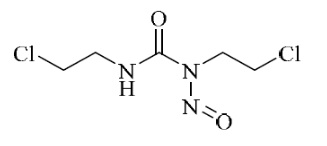
Carmustine for Injection is available in 50-mg single dose vial and 300-mg single dose vial of lyophilized material. Sterile diluent for constitution of Carmustine for Injection is co-packaged with the active drug product for use in constitution of the lyophile. Diluent vial containing 3 mL of Dehydrated Alcohol Injection and 9 mL of Dehydrated Alcohol Injection, is supplied along with drug product vial containing 50 mg of carmustine and 300 mg of carmustine respectively. Amount of dehydrated alcohol after reconstitution is 10% v/v, or 1185 mg and 7110 mg for 50 mg carmustine and 300 mg vials, respectively.
12 CLINICAL PHARMACOLOGY
12.1 Mechanism of Action
The mechanism of action of carmustine is not fully understood. While carmustine alkylates DNA and RNA, it is not cross-resistant with other alkylators. As with other nitrosoureas, it may also inhibit several key enzymatic processes by carbamoylation of amino acids in proteins. The metabolites may contribute to antitumor activity and toxicities of carmustine.
12.3 Pharmacokinetics
Distribution
Carmustine crosses the blood-brain barrier. Levels of radioactivity in the CSF are greater than or equal to 50% of those measured concurrently in plasma.
Elimination
Following a short intravenous infusion, the reported elimination half-life ranges from 15 minutes to 75 minutes.
Metabolism
Carmustine may be inactivated through denitrosation reactions catalyzed by both cytosolic and microsomal enzymes, including NADPH and glutathione-S-transferase.
Excretion
Approximately 60% to 70% of a total dose is excreted in the urine within 96 hours. Approximately 10% is eliminated as respiratory CO 2.
13 NONCLINICAL TOXICOLOGY
13.1 Carcinogenesis, Mutagenesis, Impairment of Fertility
Carmustine is carcinogenic in rats and mice, producing a marked increase in tumor incidence in doses approximating those employed clinically. Nitrosourea therapy does have carcinogenic potential in humans [see Adverse Reactions (6.1)] .
Carmustine was mutagenic and clastogenic in multiple in vitro and in vivo genetic toxicology studies.
Male rats treated with carmustine at cumulative doses ≥ 36 mg/kg (216 mg/m 2), approximately 0.15 times the maximum cumulative human dose on a mg/m 2 basis, showed decreases in reproductive potential when mated with untreated female rats (e.g., decreased implantations, increased resorption rate, and a decrease in viable fetuses).
16 HOW SUPPLIED/STORAGE AND HANDLING
How Supplied
Carmustine for Injection, USP is supplied in two different packages.
It is supplied as below:
Carmustine for Injection, USP, 50 mg per vial:
50 mg/vial (Carmustine): NDC 16729- 543-05
3 mL Sterile Diluent (Dehydrated Alcohol Injection, USP): NDC 16729- 544-85
Carton of 1 Vial Carmustine (50 mg) and 1 Vial Sterile Diluent (3 ml): NDC 16729- 545-63
Carmustine for Injection, USP, 300 mg per vial:
300 mg/vial (Carmustine): NDC 16729- 546-01
9 mL Sterile Diluent (Dehydrated Alcohol Injection, USP): NDC 16729- 547-19
Carton of 1 Vial Carmustine (300 mg) and 1 Vial Sterile Diluent (9 ml): NDC 16729- 548-63
Storage and Handling
Store product and diluent in a refrigerator 2°C to 8°C (36°F to 46°F).
Carmustine is a hazardous drug. Follow applicable special handling and disposal procedures. 1
Stability
Store the unopened vial of the dry drug in a refrigerator (2°C to 8°C or 36°F to 46°F). Store the diluent vials in a refrigerator (2°C to 8°C or 36°F to 46°F). Carmustine for Injection should be diluted immediately after reconstitution. Do not store the reconstituted solution.
Once diluted, do not store the diluted solution for more than 2 hours prior to intravenous administration.
Compatibility/ Incompatibility with Containers
The intravenous solution is unstable in polyvinyl chloride container. DO NOT USE PVC Containers.
Administer Carmustine for Injection solution from the glass bottles or polypropylene container only. Ensure the polypropylene containers used are PVC free and DEHP free.
Important Note
Carmustine for Injection has a low melting point (30.5°C to 32°C or 86.9°F to 89.6°F). Exposure of the drug to this temperature or above will cause the drug to liquefy and appear as an oil film on the vials. This is a sign of decomposition and vials should be discarded. If there is a question of adequate refrigeration upon receipt of this product, immediately inspect the vial in each individual carton. Hold the vial to a bright light for inspection. The Carmustine for Injection will appear as a very small amount of dry flakes or dry congealed mass. If this is evident, the Carmustine for Injection is suitable for use and should be refrigerated immediately.
17 PATIENT COUNSELING INFORMATION
Myelosuppression [see Warnings and Precautions (5.1)].
A serious and frequent toxicity of Carmustine for Injection is delayed myelosuppression and usually occurs 4 to 6 weeks after drug administration. Hence, patients should be advised to get blood counts monitored weekly for at least 6 weeks. The bone marrow toxicity of Carmustine for Injection is cumulative.
Pulmonary Toxicity [see Warnings and Precautions (5.2)].
Advise patients to contact a health care professional immediately for any of the following: shortness of breath, particularly during exercise, dry, hacking cough, fast, shallow breathing, gradual unintended weight loss, tiredness, aching joints and muscles, clubbing (widening and rounding) of the tips of the fingers or toes.
Seizures [see Adverse Reactions (6)]
Inform the patient that seizures may occur and advise them to get medical attention immediately in such cases.
Pregnancy [see Warnings and Precautions (5.6) and Use in Specific Populations ( 8.1 and 8.3)]
Advise pregnant women and females of reproductive potential that Carmustine for Injection exposure during pregnancy can result in fetal harm. Advise female patients to contact their healthcare provider with a known or suspected pregnancy. Advise females of reproductive potential and males with female partners of reproductive potential to use effective contraception during treatment.
Lactation [see Use in Specific Populations (8.2)]
Advise the female patient to discontinue nursing while taking Carmustine for Injection.
Manufactured For:
Accord Healthcare, Inc.
1009 Slater Road,
Suite 210-B
Durham, NC 27703
USA
Manufactured By:
Intas Pharmaceuticals Limited,
Plot No. 457/458-Matoda / Plot No.191/218P-Chacharwadi,
Sarkhej-Bavla Highway,
Taluka -Sanand, Matoda, Ahmedabad, Gujarat 382210, India.
10 4408 0 6001256
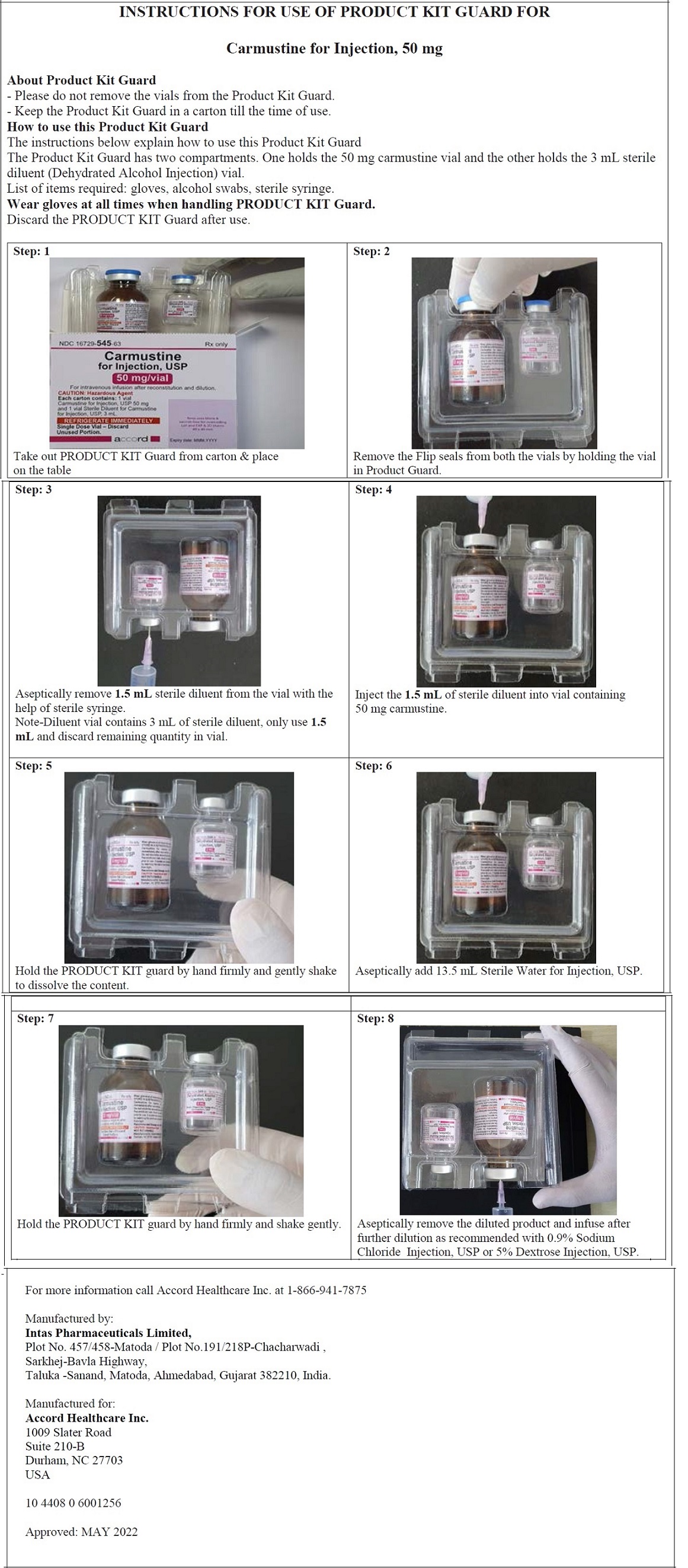
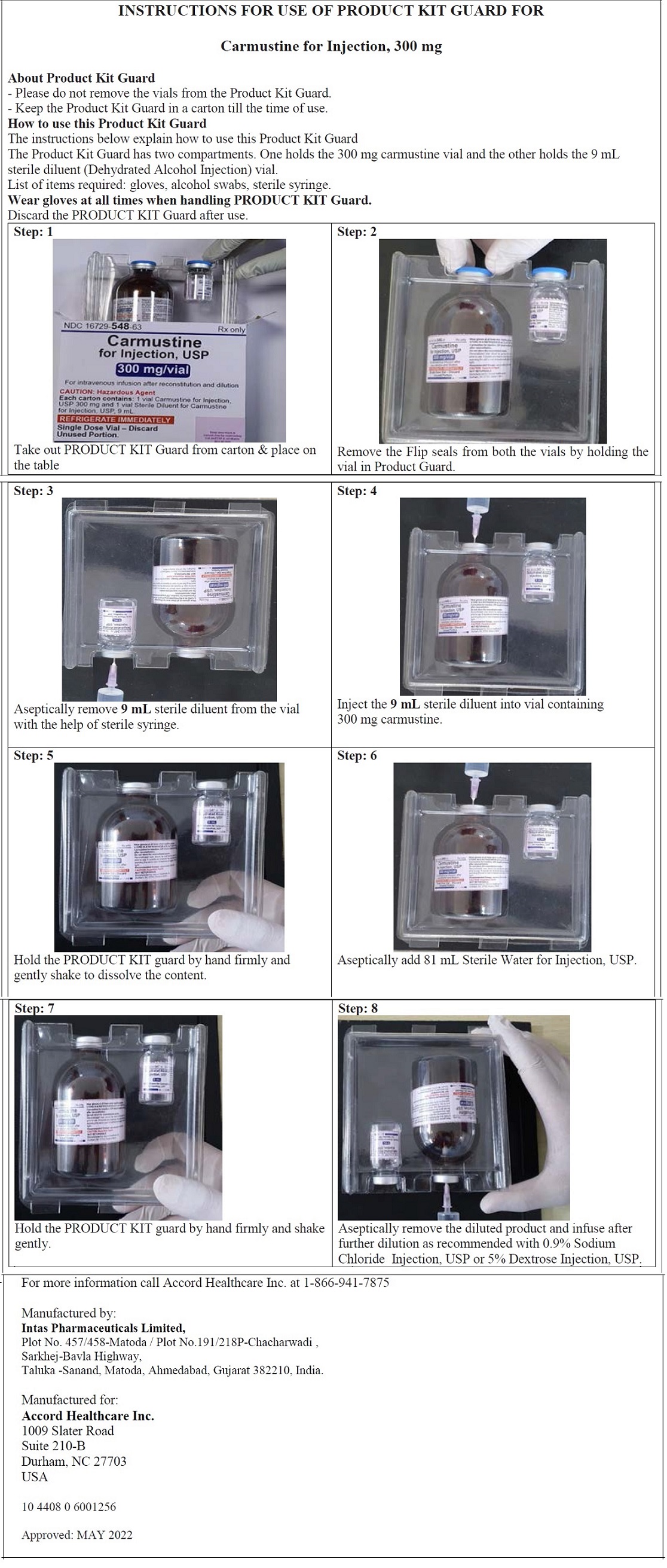
PACKAGE LABE PRINCIPAL DISPLAY PANEL - 50 mg/vial Label
NDC 16729- 543-05
Rx only
Carmustine for Injection, USP
50 mg/vial
For intravenous infusion after reconstitution
REFRIGERATE IMMEDIATELY
Single Dose Vial – Discard Unused Portion.

PACKAGE LABEL PRINCIPAL DISPLAY PANEL - 3mL diluent label
NDC 16729- 544-85
Dehydrated Alcohol Injection, USP
3 mL
Sterile Diluent for Carmustine for Injection, USP

PACKAGE LABEL PRINCIPAL DISPLAY PANEL - 50 mg/vial carton
NDC 16729- 545-63
Rx only
Carmustine for Injection, USP
50 mg/vial
For intravenous infusion after reconstitution
Each carton contains: 1 vial Carmustine for Injection, USP 50 mg and 1 vial Sterile Diluent for Carmustine for Injection, USP, 3 mL.
REFRIGERATE IMMEDIATELY
Single Dose Vial – Discard Unused Portion
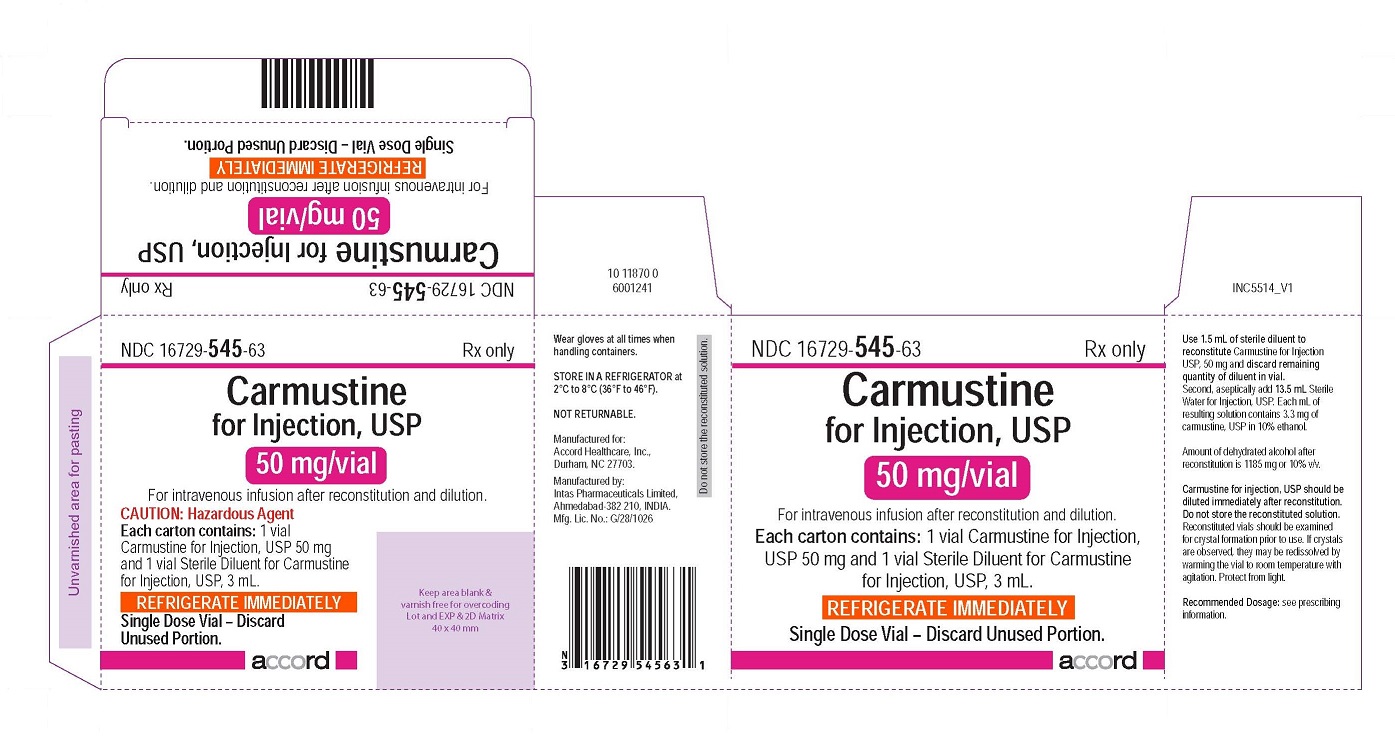
PACKAGE LABEL PRINCIPAL DISPLAY PANEL - 300 mg/vial Label
NDC 16729- 546-01
Rx only
Carmustine for Injection, USP
300 mg/vial
For intravenous infusion after reconstitution
REFRIGERATE IMMEDIATELY
Single Dose Vial – Discard Unused Portion.

PACKAGE LABEL PRINCIPAL DISPLAY PANEL - 9mL diluent label
NDC 16729- 547-19
Dehydrated Alcohol Injection, USP
9 mL
Sterile Diluent for Carmustine for Injection, USP

PACKAGE LABEL PRINCIPAL DISPLAY PANEL - 300 mg/vial carton
NDC 16729- 548-63
Rx only
Carmustine for Injection, USP
300 mg/vial
For intravenous infusion after reconstitution
Each carton contains: 1 vial Carmustine for Injection, USP 50 mg and 1 vial Sterile Diluent for Carmustine for Injection, USP, 3 mL.
REFRIGERATE IMMEDIATELY
Single Dose Vial – Discard Unused Portion
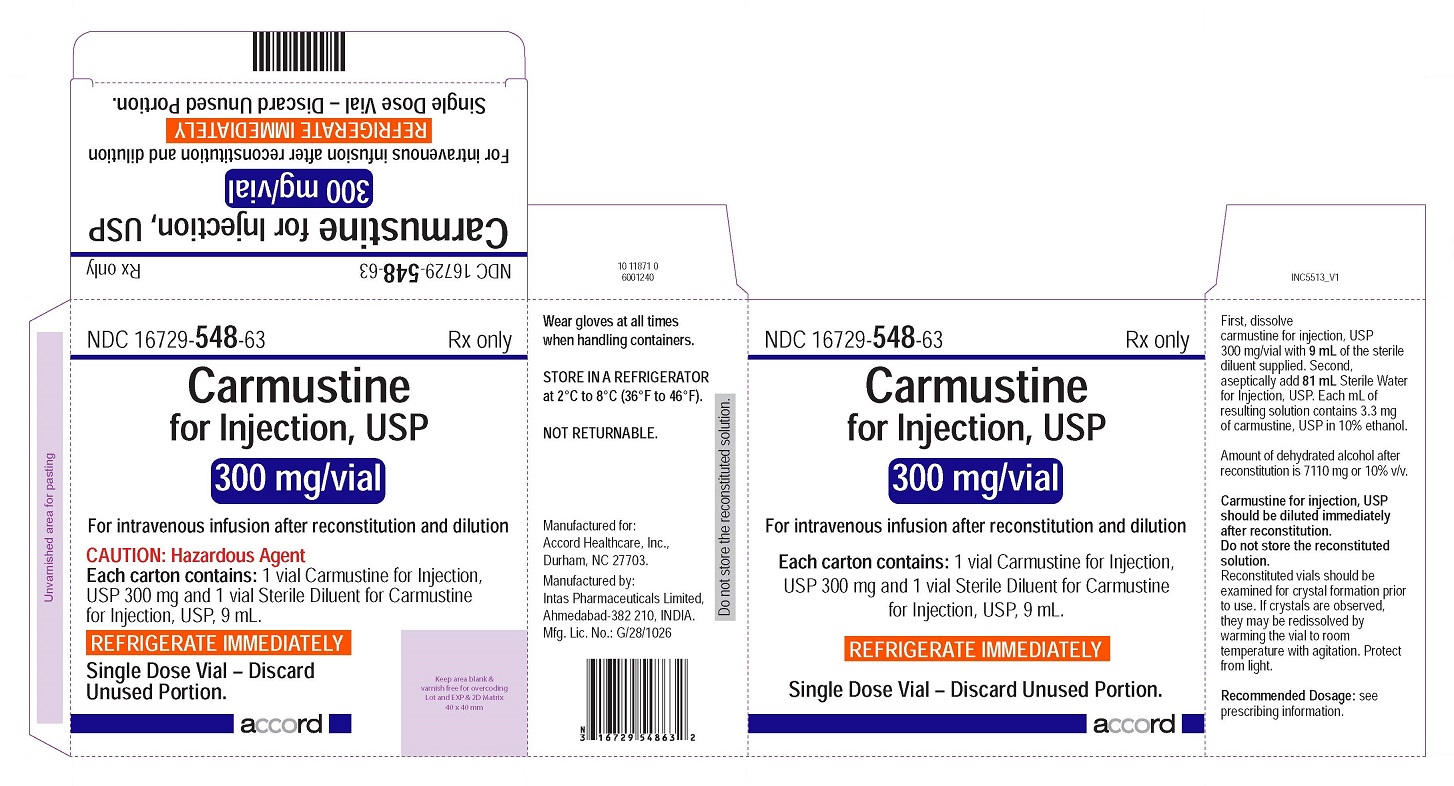
| CARMUSTINE
carmustine kit |
|||||||||||||||
|
|||||||||||||||
|
|||||||||||||||
|
|||||||||||||||
|
|||||||||||||||
|
|||||||||||||||
|
|||||||||||||||
|
|||||||||||||||
|
|||||||||||||||
|
|||||||||||||||
|
|||||||||||||||
|
|||||||||||||||
|
|||||||||||||||
|
|||||||||||||||
|
|||||||||||||||
| CARMUSTINE
carmustine kit |
|||||||||||||||
|
|||||||||||||||
|
|||||||||||||||
|
|||||||||||||||
|
|||||||||||||||
|
|||||||||||||||
|
|||||||||||||||
|
|||||||||||||||
|
|||||||||||||||
|
|||||||||||||||
|
|||||||||||||||
|
|||||||||||||||
|
|||||||||||||||
|
|||||||||||||||
|
|||||||||||||||
| Labeler - Accord Healthcare Inc. (604222237) |
| Establishment | |||
| Name | Address | ID/FEI | Business Operations |
|---|---|---|---|
| Intas Pharmaceuticals Limited | 725927649 | manufacture(16729-543, 16729-544, 16729-545, 16729-546, 16729-547, 16729-548) , analysis(16729-543, 16729-544, 16729-545, 16729-546, 16729-547, 16729-548) | |
© 2024 FDA.report
This site is not affiliated with or endorsed by the FDA.